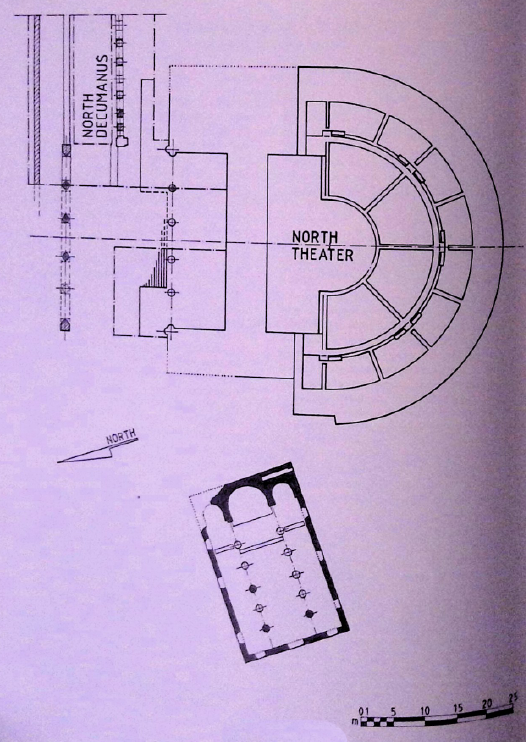Jerash - Bishop Isaiah Church
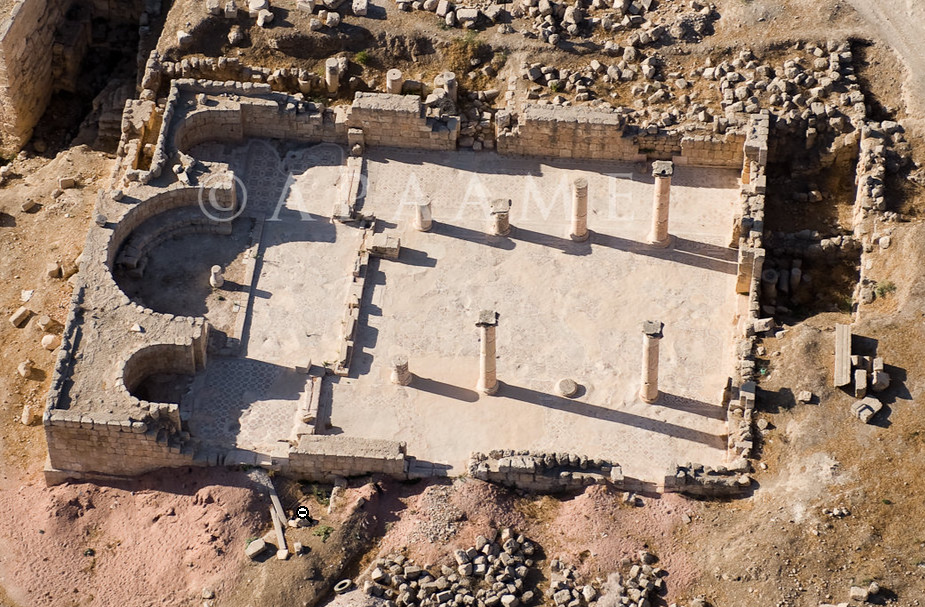 Jarash Bishop Isaiah Church
Jarash Bishop Isaiah Church
click on image to open in a new tab
Reference: APAAME_20080918_DLK-0142
Photographer: David Leslie Kennedy
Credit: Aerial Photographic Archive for Archaeology in the Middle East
Copyright: Creative Commons Attribution-Noncommercial-No Derivative Works
- from Chat GPT 5.1, 16 November 2025
- sources: Universes in Universe – The North of Gerasa, Christian Jerash (Romeartlover), Visit Jordan – Church of Bishop Isaiah, Sacred Destinations – Jerash
A mosaic inscription in the nave records that the church was built and consecrated in 558/559 CE, corresponding to year 621 of the local Gerasa era, “at the time of Bishop Isaiah.” The building therefore takes its name from the presiding bishop whose episcopate framed its foundation. Its date places it in the mature phase of Byzantine Christian life at Gerasa, when ecclesiastical patronage, urban processions, and the presence of clergy and monastic groups shaped the daily rhythms of the city.
Architecturally, the church is a three-aisled basilica with three eastern apses aligned with the central nave and side aisles. The naves are separated by rows of Ionic columns, probably reused from nearby Roman porticoes along the North Decumanus, illustrating the broader practice of spolia in late antique construction. The floors were paved with mosaics featuring geometric patterns and vegetal motifs, with the dedicatory inscription set within the pavement of the central nave. Together, its plan, mosaics, and reused architectural elements express a mid-sixth- century Christian community that adapted the Roman city fabric to new liturgical and social needs while remaining visibly anchored in the monumental landscape around the Temple of Artemis and the northern public quarter.
- Fig. 1 Plan showing the location of the church from Clark (1986)
- Fig. 2 Plan of the church from Clark (1986)
- Fig. 3 Trench location
plan of the Church Excavations from Clark (1986)
- Fig. 1 Plan showing the location of the church from Clark (1986)
- Fig. 2 Plan of the church from Clark (1986)
- Fig. 3 Trench location
plan of the Church Excavations from Clark (1986)
- from Clark (1990:176)
... It is clear from the archaeological record that the structure was destroyed by a single event, which threw all of the columns down towards the northeast, both those in the nave and those in the narthex (p. 313). One collapsed arch was found in articulation (p. 307) and the entire interior of the building was filled with collapsed masonry, lying directly upon the floor. This masonry collapse had fallen onto and sealed pottery on the floor, which was evidently in use at the time. An absence of wind-blown detritus or occupational debris overlying the mosaic floor argues against a period of abandonment prior to the collapse of the structure. An earthquake is the most plausible explanation for such a catastrophic destruction, which obviously occurred as a single event whilst the building was still in use. The pottery and coins sealed by this collapse suggest a mid 8th century date.
- from Clark (1986:313,315)
There is no evidence as to whether the church was still in use as such when it was destroyed, although the paucity of internal fittings and cult objects found suggests that it was not. What is clear is that the structure was undergoing some repairs at the time. In the south aisle (trenches F.VI and X) was found a stock of twenty-four roof tiles, arranged in three rows (plate 59), two grey ware basins, nineteen grey ware bowls, a juglet and a jar. In the north aisle (trench F.XII) two stacks of imbrex roof tiles were found. At the west end of the south aisle a patch of plaster covered the mosaic and extended up over the lower part of the walls. This appeared to have resulted from the mixing of plaster on the floor. A group of grey ware basins was found strewn around this patch of plaster and a large lithos was found set into clay against the rear wall (trench F.XIII). The basins were all of the type often found with deposits of plaster on the interior and were probably used for carrying wet plaster.
All of this suggests that the church was undergoing repairs to the roof, and perhaps to the interior of the walls, at the time of destruction. That the plaster of the interior walls was in bad condition is clear from the fact that fallen wall plaster was found on the floor beneath the stacked roof tiles and pottery vessels.
The building then lay abandoned until the Mamluk period, when the adjacent North Theatre was reoccupied. At this time the north chancel area and apse seem to have been cleared to the mosaic and reused. Presumably the northeastern corner of the church was then in a better state of preservation than at the present day. A small room was created by extending the apse wall to the west and then closing the apse off with a wall to the west. A door opened through this latter. A low platform, formed of red clay and small stones, covered by smooth yellow clay, was built in the southwest corner of this room (pl. X,20). Mamluk pottery was found on and beneath this platform and on the mosaic floor. A pit cut through the mosaic was also found to contain Mamluk pottery.
No further occupation of this area has occurred and the church has lain in ruins from approximately the 15th century up until the present day.
13 Strong earthquakes which may have destroyed the church ocurred in 717 AD and 746 AD. Without further analysis it is impossible to attribute the destruction to a specific date. See, howevere, R.H. Smith, Pella of the Decapolis, College of Wooster, 1973), pp. 163-167 for a discussion of these earthquakes with regard to Pella. JW: I would advise against this.
| Century (AD) | Event (AD) attribution by original author |
Reliability of interpreted evidence |
Likely attributable seismic event (AD) |
Locality | Plan ref. | Reference |
|---|---|---|---|---|---|---|
| 8th | 749 | Medium | 747–749 | Bishop Isaiah Church | 2 | Clark 1990, 176. |
| Seismic Effect | Location | Image(s) | Description |
|---|---|---|---|
|
Isaiah Church
 Plan of Jerash. North is to the right.
Plan of Jerash. North is to the right.
Click on image to open in a new tab Holger Behr - Wikipedia - Public Domain |
|
- Modified by JW from Fig. 3 of Clark (1986)
- Earthquake Archeological Effects chart
of Rodríguez-Pascua et al (2013: 221-224)
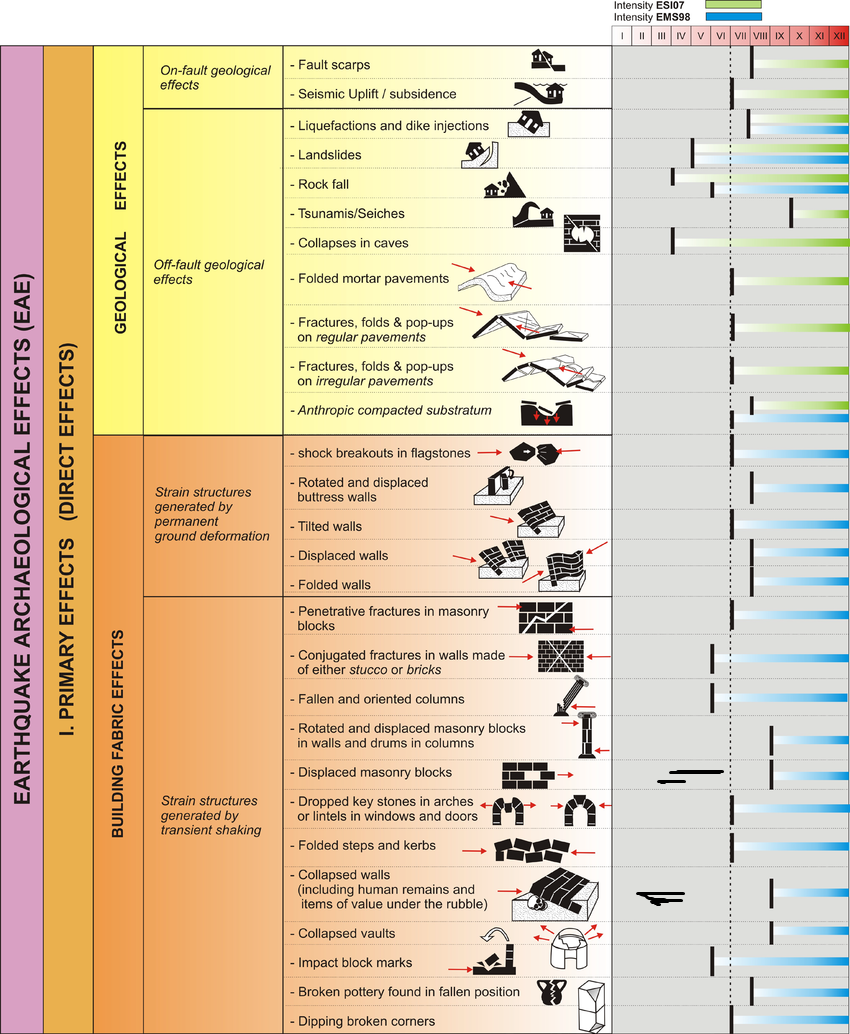
 Earthquake Archeological Effects (EAE)
Earthquake Archeological Effects (EAE)
Rodríguez-Pascua et al (2013: 221-224)
| Seismic Effect | Location | Image(s) | Description | Intensity |
|---|---|---|---|---|
|
Isaiah Church
 Plan of Jerash. North is to the right.
Plan of Jerash. North is to the right.
Click on image to open in a new tab Holger Behr - Wikipedia - Public Domain |
|
|
Clark, V.A. (1986) The Church of Bishop Isaiah of Jerash. In F. Zayadine (Ed.), Jerash Archaeological Project, 1: 1981-1983 (pp. 137-162). Amman: Department of Antiquities.
- open access at archive.org
Clark, V. A. (1990). The Bishop Isaiah Church at Gerash: A Brief Note. Zeitschrift des Deutschen Palästina-Vereins, 106, 175-176.
- at JSTOR
Lichtenberger, A. and Raja, R. (ed.s) (2025) Jerash, the Decapolis, and the Earthquake of AD 749 The Fallout of a Disaster
Belgium: Brepols.
- from Lichtenberger and Raja (2025)
- Table 2.2 List of seismic damage
in Jerash between the 1st and 19th centuries CE from Lichtenberger and Raja (2025)
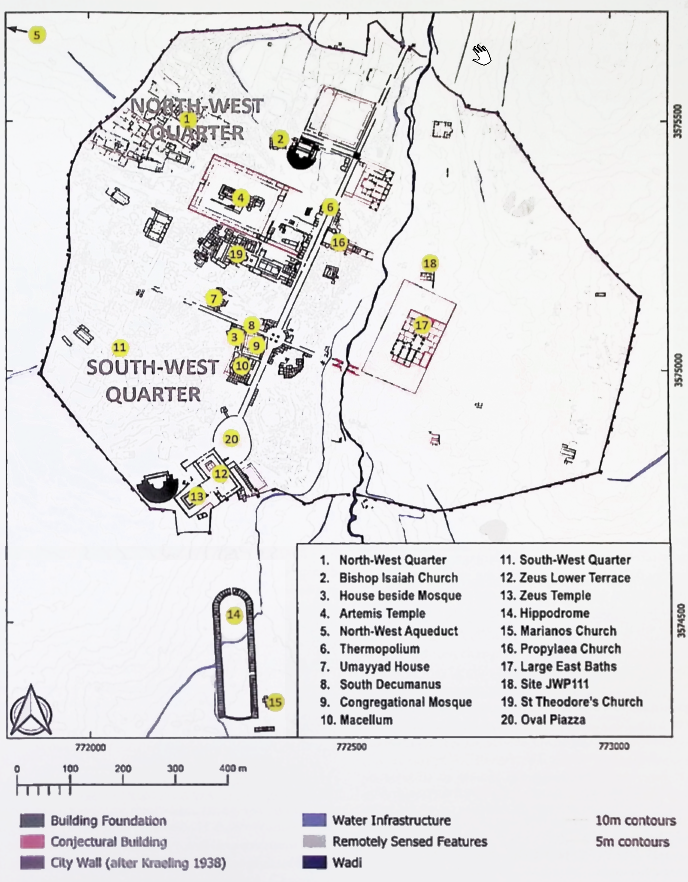 Figure 2.6
Figure 2.6Plan of ancient Gerasa showing the location of earthquake-damaged sites referred to in Table 2.2
(after Lichtenberger, Raja, and Stott 2019.fig.2)
Click on Image to open in a new tab
Lichtenberger and Raja (2025)
- from Lichtenberger and Raja (2025)
- Fig. 2.6 Map of seismic damage
in Jerash between the 1st and 19th centuries CE from Lichtenberger and Raja (2025)
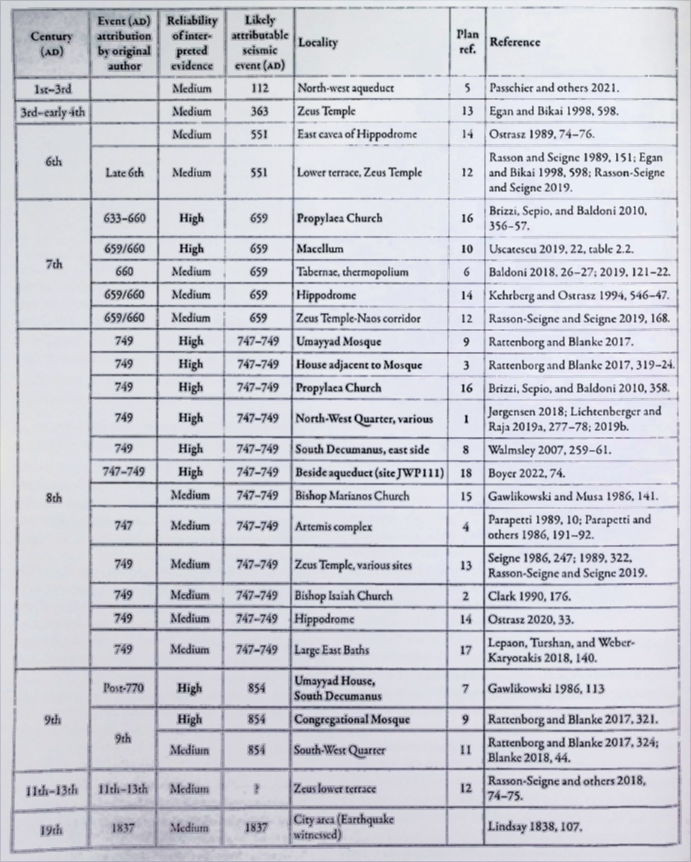 Table 2.2
Table 2.2List of seismically induced damage recorded in Gerasa where the relaibility of the evidence is considered to be medium or high
Click on Image to open in a new tab
Lichtenberger and Raja (2025)

